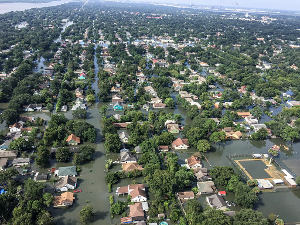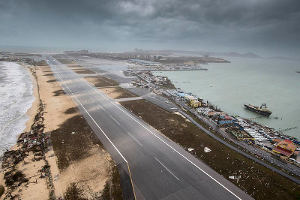Irma and Harvey, most destructive hurricanes in 2017
An intense Atlantic hurricane season in 2017
 |
The first alert was launched late August with the emergence of hurricane Harvey, not far from Texan coasts. No sooner had insurers started to count the losses triggered by this first hurricane than a second major event, mildly called Irma rose on the horizon.
Irma, born in early September in the arch of the Caribbean, successively devastated French and British Antilles, Cuba before ending up in Florida. Within the same period, Katia and José, two other depressions formed and picked up into a hurricane category. Torrential rain has once again washed Mexican, American and Caribbean coats. Finally, in mid-September, Maria, a simple tropical storm, had turned into a mighty hurricane within just two days.
For many scientists, there is nothing unusual about these successive waves of extreme weather phenomena are as the region has previously sustained similar stormy cyclonic seasons.
Other scientists find that reporting so many hurricanes devastating the isles of the Atlantic Basin in such a short period of time is really exceptional.
The American agency North Oceanic and Atmospheric Administration (NOAA) finds that this year's cyclonic activity is indeed well above the average level with forecasts of 14 to 19 storms and nine major hurricanes looming on the horizon.
The North Atlantic season starts in June and ends in November with highs in September. The average number of disasters amounts to 12 tropical storms and 6 hurricanes per season, 2.7 of which are major events (reaching at least category 3 over the Saffir-Simpson scale).
Hurricanes in 2017: Harvey worse than katrina
Having occurred in late August 2017, tropical storm Harvey, category 4 over the Saffir-Simpson scale, washed the States of Texas and Louisiana. It swept in its passage the city of Houston as well as several coastal regions.
Considered as one of the most devastating hurricanes since Katrina (2005), Harvey has left behind a trail of destruction with spectacular floods. In five days, nearly 30% of the Harris County and its 4.5 million inhabitants found themselves covered by water. Harvey inundated dwellings and infrastructure, bringing factories and refineries to a standstill. Approximately one million vehicles have been damaged while several important sites have sustained damage. That is the case of French chemical products company, Arkema, which was faced with several fires and explosions, triggering water and air pollution.
According to a toll set on September 14, 2017, the authorities have reported no less than 82 deaths.
Hurricanes in 2017: Irma, a second major calamity
Several days following the passage of Harvey, another hurricane lashed the Atlantic. Ranked in category 5 in the Saffir-Simpson scale over three successive days, Irma has been reckoned among the most powerful events ever reported with 7000 kilometers crossed from Cape Verde to Florida, wind gusts exceeding 300 km/h and tidal waves of 12 meters.
 |
Having ravaged several isles in the Caribbean, including Saint-Martin and Saint Barthélemy with respectively 95% and 70% of buildings destroyed or seriously damaged, hurricane Irma hit Cuba hard before entering the archipelago of Keys and Florida. In Florida State, the first toll refers to considerable material damage affecting property and infrastructure. Cotton and citrus crops have been totally lost while more than 6.3 million dwellers had to be urgently evacuated from Florida. The provisional death toll is of 12 people in Florida and 40 others in the Caribbean.
Harvey and Irma economic and insured costs
The economic losses triggered by hurricanes Harvey and Irma have been estimated by AccuWeather(1) at 290 billion USD, that is 1.5% of United States’ GDP.
Hurricane Harvey
According to the estimates of the governor of Texas, economic losses range between 150 and 190 billion USD. Such a cost would make hurricane Harvey the most costliest natural catastrophe of the United States for 30 years.
For some estimates which consider the costs of the disaster to be lower, the amount varies between 50 to 100 billion USD.
The bulk of the losses sustained will be covered by the Federal Emergency Management Agency (FEMA) and the National Flood Insurance Program (NFIP).
In the United States, risks related to water damage is excluded from standard homeowner's policy which covers solely damage caused by wind. Consequently, only 12% of American households were endowed with coverage against this hazard in 2016.
For the Texas floods, NFIP will provide compensation for the 17% of the owners having underwritten water damage cover. They will be entitled to 250 000 USD in reconstruction expenses and up to 100 000 USD for the loss of personal effects. Unfortunately, NFIP, operational for 50 years now, is heavily indebted, hence the substantial risk of insolvency.
According to AIR Worldwide, local insurers will be required to cover up to 10 billion USD whereas economic losses are poised to exceed by far 75 billion USD. According to Munich Re, the bill for hurricane Harvey is likely to cost the entire market 30 billion USD.
(1)Private weather service
Hurricane Irma
Crossing west coast Florida upwards, tropical depression Irma changed itinerary, thus losing steam and sparing the disaster scenario by miracle. The opulent cities of Miami, where most assets under risks are estimated at more than 1 200 billion USD, have been spared.
Following the initial estimate comprised between 90 and 120 billion USD, analysts have revised their figures downwards.
Still, according to AIR Worldwide, insured losses are set to be comprised between 20 and 40 billion USD for just the United States. The aggregate bill for Irma, after consideration of the damage sustained by other countries, is poised to cost insurers 65 billion USD.
Harvey and Irma's impact on the Insurance Industry
Insurers will have to face important events without, however, sustaining major losses.
These limited losses are accounted for by:
- the low share of damage, nearly 20% being born by private insurance companies (versus approximately 40% for Katrina).
- the absence of major catastrophes since Katrina and Sandy enabled the market to rebuild its provisions which are now set at their highest level. Insurers have enough reserves to cope with such claims.
Insurers will also be able to benefit from capital inflow and from the development of alternative reinsurance capital cat bonds. With sums of more than 8.55 billion USD, these bonds related to natural catastrophes reached a record high in the first half of 2017.
Ten costliest Atlantic hurricanes (1)
In billion USD
| Date | Name of hurricane | Place | Economic cost | Insured cost | Number of deaths |
|---|---|---|---|---|---|
09/ 2017 | Irma(2) | Antilles, Cuba, Florida | Between 90 et 120 | 65 | 52 |
08/ 2017 | Harvey(2) | Texas, Louisiana | 180 | 30 | 60 |
2005 | Katrina | New Orleans, Louisiana | 160 | 79.7 | 1 800 |
2012 | Sandy | East coast of the United States, Caribbean, Cuba, Canada | 70.2 | 36.1 | 210 |
1992 | Andrew | Bahamas, Florida, Louisiana, South of the United States | 26.5 | 17 | 62 |
2008 | Ike | Bahamas, Haiti, Cuba, Golf of Mexico, Louisiana, Texas, Canada | 38 | 18.5 | 170 |
2004 | Ivan | Caribbean, Cuba, Mexico, Venezuela, East of the United States, south-east of Canada | 23 | 13.8 | 123 |
2005 | Wilma | Caribbean, Cuba, Bahamas, Mexico, Florida | 22 | 12.5 | 44 |
2005 | Rita | Cuba, Bahamas, Florida, Louisiana, Texas, Mississippi, Arkansas | 16 | 12 | 10 |
2004 | Charley | Cuba, Antilles, Jamaica, Southeastern United States | 18 | 8 | 36 |
(1)Status at the end of September, 2017
(2) High estimates Source: Statista, National Oceanic and Atmospheric Administration, Munich Re
Saffir-Simpson scale The scale that grades the intensity of tropical hurricanes which form in the Western Hemisphere, North Atlantic and North-East Pacific. The classification, which includes five levels, is set according to wind speed. Major hurricanes are referred to as such when they reach category 3 or more. | Ranking | Wind speed |
|---|---|---|
| 1 | 118 and 153 Km/h | |
| 2 | 154 and 177 Km/h | |
| 3 | 178 and 209 Km/h | |
| 4 | 210 and 249 Km/h | |
| 5 | Higher than 249 Km/h |
